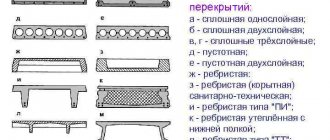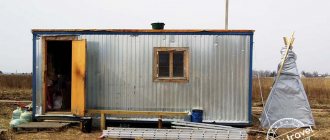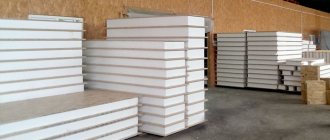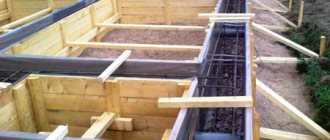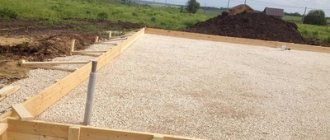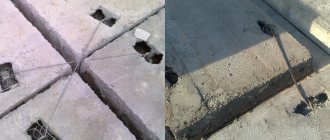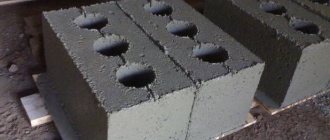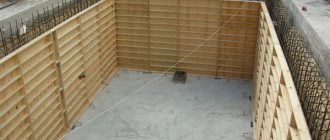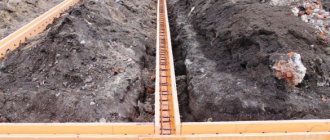Using the design
Today, such a branch of the national economy as construction is developing very actively. In recent years, many different methods of constructing certain structures have been developed, and new building materials have been introduced into practice. Currently, the most popular of them are brick, concrete, reinforced concrete, plastic and others. All of them are widely used in construction. Concrete occupies a special place among them. It is an artificial building material that has high strength, obtained by mixing the following components: sand, cement powder, crushed stone and water. Often, various additives are additionally introduced into it (stabilizers, water repellents, etc.).
Scheme of a concrete monolithic slab.
Concrete is an indispensable component in the construction of houses. This is what the foundation is made from. Typically, concrete slabs are used for this, which you can make yourself. The foundation is the support and foundation for most large structures and buildings. The strength and stability of the structure itself largely depend on the quality of concrete. Let's take a closer look at how to make a concrete slab with your own hands and the technique of work.
Installation features
There are 2 methods of pouring and erecting concrete slabs. If the first consists of pouring the mixture on the construction site and, due to its greater strength, it is preferred, then the other is the assembly of several products. Calculations of slab parameters and purchasing or making the mortar yourself are carried out before pouring. To prepare, mix sand, cement, crushed stone - 3:1:5. Water is added in an amount of 60% of the total mass: in frosty weather - warm, in hot weather - cold. In addition, in winter it is necessary to add frost-resistant substances (1.5% of the total weight). When buying a finished product, pay attention to the characteristics of strength, durability, and reliability. Recommendations from experienced builders in choosing indicators: frost resistance - not lower than F200, water resistance - above W8, mobility - P3.
Monolithic foundation and Swedish slab
Scheme of a concrete slab with a reinforced screed.
Before you make a slab with your own hands, you need to know what types of foundations there are and what is typical for them. Very often, builders resort to constructing a monolithic foundation. It is excellent for low-rise construction. It is relevant in the presence of heaving soil. Unlike a shallow strip foundation, it has a number of advantages. Of great importance is the fact that a monolithic slab is indispensable for buildings and structures with high sensitivity to deformation. These are houses made of aerated concrete and non-elastic brick. The plate can be ribbed or flat. In the first case, it can withstand the load of the building well, but is more difficult to manufacture.
The second type of foundation, which is very popular, is the so-called Swedish slab. This is an innovation in this industry. It is characterized by the fact that in most cases it is done together with insulation. All communications are laid hidden. As in the previous case, it is relevant for low-rise buildings. It is also important that working with it takes little time. The Swedish stove is not afraid of temperature changes or swampy soil. The level of its laying may vary depending on the type of structure. The Swedish stove is quickly and easily erected with your own hands, which makes it almost irreplaceable.
Technology for producing concrete and reinforced concrete products
Home Favorites Random article Educational New additions Feedback FAQ⇐ PreviousPage 19 of 34Next ⇒
And designs
The production of concrete and reinforced concrete products and structures includes the following technological stages: incoming quality control of all materials used (mineral binder, fillers, additives, water, reinforcement, etc.); calculation of the composition of the concrete mixture and its laboratory testing; preparation of a given concrete mixture; transporting it to the place of manufacture of the structure; laying in shape (formwork) and compaction; concrete hardening; opening the form (removing the formwork); sending the finished product to the construction site or finished product warehouse.
The calculation of the composition of the concrete mixture is carried out according to GOST 27006 using graphs and tables based on the following data: operating conditions of the future structure, taking into account which the necessary starting materials are selected; indicators of their quality; the designed grade of concrete; plasticity of the concrete mixture, which is selected depending on the size of the structure being concreted; reinforcement density; method of compacting concrete mixture. The correctness of the calculations is checked in laboratory conditions by making prototypes from the calculated composition and monitoring their strength.
Based on the manufacturing method, structures are divided into monolithic and prefabricated . When concreting monolithic structures - foundations, hydraulic structures, road surfaces, the concrete mixture is prepared in a factory and transported to the construction site, where other technological operations are carried out. Prefabricated structures are produced at specialized factories (concrete products, reinforced concrete products, KSM). Depending on the shape and size, they can be linear - columns, crossbars, piles; flat – covering slabs, wall panels, partitions; block - foundations, basement walls; spatial - sanitary cabins, elements of elevator shafts, silos, wells (Fig. 6.1).
Rice. 6.1. Prefabricated reinforced concrete structures:
1 – column; 2 – outer panel; 3 – internal panel;
4 – flight of stairs; 5 – hollow-core floor slab
While maintaining the general consistency of the technology for producing prefabricated reinforced concrete, depending on the range of products produced, various technological lines are used that take into account the specifics of the structures being produced. When choosing one or another line, take into account the type and grade of concrete, the shape, size and weight of the product, the complexity of execution, the type of reinforcement, the saturation of reinforcement and embedded parts. This information is necessary for maximum compatibility of operations during the production of products. The most widely used production methods are: flow-aggregate, conveyor and stationary, which are divided into bench, cassette and block [1].
The flow-aggregate method involves the production of products in molds that are moved to separate technological stations using a crane. This method is preferable for small-scale production of structures up to 12 m long, up to 3 m wide and up to 1 m high, complex in technology - multi-layer wall panels, coating slabs.
The conveyor method provides high mechanization and labor productivity, since products are manufactured using the continuous molding method. The production line itself is a moving metal belt on which a form with concrete mixture moves from one technological station to another. The speed of the belt is determined by the longest process – heat treatment and is about 25 m/h. The rational area of application of this production line is the production of the simplest flat products of one type: floor panels, coatings and internal partitions, airfield and road slabs.
In the bench method, products are molded and left to harden in stationary, non-moving molds. It is advisable to use it for the manufacture of such large-sized structures as trusses and long-sized prestressed beams.
Using cassette technology, floor slabs, panels of internal walls and partitions are produced. As stationary forms, vertical cassettes are used, consisting of several compartments filled with concrete mixture, limited by steel walls with mounted vibrators located on them for uniform compaction of the concrete mixture and steam jackets that ensure heating of concrete products. The main advantage of this method is the sharp reduction in production space. The next method involves the production of complex volumetric elements. When molding volumetric blocks (sanitary cabins, elevator shafts) on a “cap” type installation, first a reinforcement frame is mounted, then the mold panels are secured and the walls and ceiling of the block are concreted. Warming up of products is carried out on site by heating the core. To remove the finished product, the core is lowered down (Fig. 6.2).
In the manufacture of structures whose operating conditions are associated with the action of large tensile and bending loads, prestressed reinforcement is used to increase the crack resistance of concrete.
Rice. 6.2. Scheme for forming volumetric blocks:
a – installation of fittings; b – assembly of the form before concreting;
c – concreting the walls of the block; d – removal of the finished block
In this case, the concrete is artificially compressed by pre-stretched reinforcement in contact with it and works in tension only when the tensile stresses exceed the compressive stresses. One of the creators of prestressed concrete was the Soviet scientist researcher V. Mikhailov. There are two main methods of tensioning reinforcement: before concreting the structure and after concreting . In the first case, the reinforcement is pre-stretched using jacks or electrothermal methods and the ends are fixed in the mold. After laying, compacting the concrete mixture and gaining a certain strength with concrete, the ends of the reinforcement are cut off. The reinforcement, trying to return to its original unstressed state, compresses the concrete in contact with it, transferring it to a compressed state. In structures with tensioned reinforcement, after concreting, the reinforcement is placed in special channels formed in the concrete by void-forming pipes, inserted into the mold before concreting and removed from the concrete after it reaches a certain strength. Then the reinforcement is tensioned, its ends are secured and the channels are filled with cement-sand mortar. The reinforcement is released after the solution has reached a certain strength. For prestressed structures, high-grade concrete and high-strength reinforcing steel are used in the form of individual strings or ropes made of high-strength wire, as well as large-diameter rods of periodic profile.
Prestressed structures are more effective than conventional ones, since better use of the load-bearing capacity of reinforcement and concrete can significantly reduce the weight of products, their material consumption, and increase crack resistance and durability. The range of products that are advisable to be manufactured with pre-tensioned reinforcement are building coverings, bridge spans and supports, reinforced concrete piles and pipes, sleepers, power line supports, television towers, floating docks, protective shells.
In world practice, industrial, civil and residential buildings, dams and energy complexes are erected from prestressed monolithic reinforced concrete. An example of such construction is the Moscow TV tower with a height of 537 m, where prestressed reinforced concrete is the main material up to 380 m, as well as the tallest TV tower (555 m) in Toronto.
When constructing long-span cable-stayed bridges, prestressing reinforcement is placed in channels without filling them with mortar or concrete, i.e. the adhesion of these two components of reinforced concrete is eliminated. In this case, the reinforcement is protected from corrosion either by special shells or anti-corrosion compounds. The world record for such structures belongs to the Normandy Bridge, where the span reaches 864 m. This material is also indispensable for reactor vessels and containment shells of nuclear power plants. It was the absence of such a shell that was one of the reasons for the Chernobyl disaster.
Prestressed concrete can also be obtained by using prestressing cement of a specially selected composition. Compressive stresses in concrete arise as a result of the formation of coarse-crystalline cement hydration products, leading to significant expansion of the cement stone. Since this expansion occurs in a closed volume limited by shape, compressive forces are transferred to the concrete, which increases its crack resistance during operation.
The concrete mixture is produced at centralized concrete mixing units (plants) in the form of a plastic material that is cohesive and homogeneous, or from a dry mixture of components. In the first case, the concrete mixture is ready for the manufacture of structures (BSG), in the second, its use is possible after additional introduction of water and thorough mixing of the components directly at the construction site (BSS). This is convenient when the construction site is located far from the concrete plant.
Preparation of a concrete mixture includes preparation of materials, their dosing and mixing. Most operations for the preparation of aggregates: crushing, removal of contaminants, separation into fractions and other similar operations are carried out at enterprises producing non-metallic materials. Heating of aggregates during winter concreting is carried out in warehouses or in bunkers at the factory using steam pipes or by directly passing steam or hot air through the aggregate. An aqueous solution of additives of the required concentration is prepared in a special container equipped with a piping system for supplying compressed air and steam to improve mixing.
Prepared materials are weighed using special equipment - dispensers (weight and volume): cement, water, additives - with an accuracy of 1%; aggregates – up to 2% and fed into a concrete mixer. The operating principle of this unit depends on the properties of the concrete mixture. To obtain plastic mixtures with dense aggregates, free-fall mixers are used, in which mixing occurs due to the rotation of the drum and repeated lifting and dropping of materials from a certain height. Mixtures that are rigid and based on porous aggregates are produced in forced mixers. More vigorous mixing for 2 - 5 minutes is achieved by using rotating blades.
The quality of a concrete mixture is assessed by its cohesion , homogeneity and workability - formability . These properties depend on the viscosity and amount of cement paste that envelops the aggregate and fills the voids between it. The amount of cement paste must be sufficient for this multi-component system to acquire coherence, i.e. turned into a structured homogeneous system with certain physical and mechanical properties. An increase in the content of cement paste above the optimum in a concrete mixture and, consequently, of cement stone in concrete, a relatively porous material compared to a dense aggregate (Fig. 6.3), leads to a decrease in a number of performance properties. Shrinkage and creep of concrete increase, excessive heat generation during hydration leads to the appearance of cracks and a decrease in strength, frost resistance (Fig. 6.4), and water resistance [1].
Rice. 6.3. Dependence of total (solid lines) and capillary
(dashed lines) porosity of cement stone
on the content of cement paste [1]
Rice. 6.4. Reference curve for frost resistance of concrete
from capillary porosity [1]
In order for the concrete mixture to become mobile and easily fill a certain volume, it is necessary not only to fill the voids, but also to spread the aggregate grains apart with layers of cement paste. The greater the sliding, the easier it is for the aggregate to slide relative to each other and, therefore, the higher the plasticity of the mixture. Depending on the properties (dense or porous) and the ratio between fine and coarse aggregates, the minimum content of cement paste in the concrete mixture, ensuring its non-segregation and high-quality compaction, is 170 - 200 liters in a rigid mixture and up to 220 - 270 liters in a mobile and cast mixture.
Let's consider how the properties of the components influence the mobility of the concrete mixture at a constant water consumption. The finer the grind of the cement and the more ground additives it contains - tripoli, diatomaceous earth, opoka (pozzolanic Portland cement), the stiffer the concrete mixture. This is due to an increase in the total surface area of the particles, which must be covered with a thin layer of water to obtain a plastic mixture.
Mobility also depends significantly on the shape, size and surface cleanliness of the aggregates. Dust-like impurities, adsorbing part of the mixing water on their surface, increase the water requirement of the concrete mixture, reducing its mobility. The ratio between sand and crushed stone also has a great influence. Thus, mobility increases with an increase in the proportion of coarse aggregate and the use of rounded gravel.
With increasing water content, the plasticity of the mixture increases significantly [1]. Each concrete mixture has a certain water-holding capacity, which is determined experimentally. With a high water content (Fig. 6.5), the viscosity of the cement paste becomes insufficient to hold the aggregate in suspension and distribute it evenly throughout the entire volume. Dense heavy aggregate settles under the influence of its own mass, and the concrete mixture separates. Excess water, as the lightest component, flows around the aggregate grains and is pressed upward. Capillary passages are formed, reducing the frost resistance and water resistance of concrete, which increase slightly as a result of subsequent hydration (Fig. 6.6). Water also accumulates under the grains of coarse aggregate, forming cavities that worsen the structure and properties of concrete. This process is especially intense during compaction. The observed delamination violates not only the homogeneity of the concrete mixture, but also the concrete in structures during its hardening. Therefore, water separation is strictly limited and can range from 0.1 to 0.8%, depending on the workability of the mixture. Delamination can be eliminated by reducing water consumption, increasing cement consumption, introducing additives of plasticizers and superplasticizers, increasing the content of fine aggregate and using special additives that increase the viscosity of the cement paste (for example, highly hydrophilic bentonite clay) [26].
| Rice. 6.5. Water separation in cement paste depending on the relative water content [1] | Rice. 6.6. Change in water resistance of concrete over time [1] |
In practice, the most important characteristic of a concrete mixture is its workability - the ability to uniformly occupy a certain volume under the influence of its own gravity, if the mixture is highly plastic, or the application of a load, for example, vibration with a rigid concrete mixture. To assess workability, depending on its plasticity, the following indicators are used: mobility and rigidity. Mobility is determined for plastic concrete mixtures by measuring the settlement in centimeters of a truncated standard cone molded from the concrete mixture. This indicator is a static characteristic of the structural strength of the concrete mixture, because its settlement occurs under the influence of its own mass. Depending on the cone settlement (PS), there are low-plastic mixtures (P1, P2) with DC of 1–4 and 5–9 cm, respectively, plastic mixtures (P3, P4) with DC of 10–15 and 16–20 cm, and cast mixtures (P5) with OK more than 20 cm. In the presence of hard mixtures with OK less than 1 cm, another indicator is used - hardness. This is a dynamic characteristic of the viscosity of a concrete mixture, because it is determined using vibration. In practice, rigidity is assessed either using the simplified method of Prof. B.G. Skramtaev in terms of vibration time in seconds, sufficient to fill a molded truncated concrete cone with a cube of a certain size, or using a special device. Super-hard mixtures include mixtures with vibration times from 100 or more to 41 s (SZh 3, 2, 1) and hard ones from 40 to 5 s (Zh 4, 3, 2, 1) (STB 1035-96).
Indicators of mobility and rigidity are assigned taking into account the saturation of the reinforcement, the surface modulus of the concreted structure and the horizontal or vertical location of the form during compaction. The plasticity of a concrete mixture can be increased by increasing the water-cement ratio, introducing the addition of a plasticizer and superplasticizer, increasing the consumption of cement and reducing the consumption of fine aggregate. From the above it follows that the properties of a concrete mixture depend on the quantity and properties of the constituent components.
After preparation, the concrete mixture is transported to the placement site. On the territory of the plant, belt conveyors are used for this purpose, as well as general delivery methods suitable for both the production of monolithic and prefabricated reinforced concrete: dump trucks, concrete mixer trucks, concrete trucks. One of the progressive methods of supplying concrete mixture to construction sites, workshops and plant sites is pipeline transport. It is convenient for supplying large volumes of concrete mixture to structures to which vehicle access is difficult or impossible, during underground construction, where supply of the mixture by construction cranes is excluded. Another advantage of pipeline transport is the possibility of continuous supply of concrete mixture to the work site, which is carried out pneumatically or hydraulically - with concrete pumps.
Before supplying the concrete mixture, the mold is prepared: cleaned, lubricated, and reinforcement and embedded parts are laid according to the design. When molding concrete and reinforced concrete products and structures, the property of the concrete mixture is thixotropy. This is the ability of a multicomponent plastic composition to reduce viscosity under the influence of load (vibration) as a result of disruption of adhesion between particles and restore structural integrity and strength when mechanical stress is removed. Thus, the concrete mixture has, on the one hand, the properties of a liquid capable of occupying a certain volume, and on the other, a solid body with structural strength.
In precast concrete factories, products usually formed on special vibrating platforms . To compact super-hard mixtures, vibration with a weight is used: vibrocompression, vibration stamping, for cast ones - vibrovacuuming, based on partial removal of water due to the pressure difference created on the upper and lower surfaces of the structure being concreted. Recently, impact and vibration-free compaction methods have become widespread, which provide energy savings and reduce the risk of vibration effects on workers. In the impact method of manufacturing products, molds with a plastic concrete mixture are repeatedly raised and lowered from a small height. In this case, gradual compaction and uniform distribution of the concrete mixture throughout the volume occurs. Of the vibration-free methods, the best known are the pouring, ramming and centrifugation .
In the pouring method, highly mobile cast concrete mixtures are used, which are evenly distributed when poured into the mold. To eliminate possible delamination, finely ground mineral additives or additives of plasticizers and superplasticizers are introduced into them while maintaining the water-cement ratio.
Depending on the sequence of preparation of the mixture, syringe concrete and shotcrete using the ramming method Both are fed into the mold or onto the surface to be protected under compressed air pressure. The difference is that in the first case, a dry mixture of sand and cement is mixed with water directly at the exit from the nozzle, in the second, a relatively plastic composition is prepared in advance and fed under pressure into the mold. For the manufacture of hollow products - pipes, columns, a centrifugal molding method is used, based on uniform distribution over the surface of the mold and compaction of the supplied concrete mixture under the action of the centrifugal force that occurs during rotation.
When manufacturing monolithic structures, formwork and reinforcement are first installed. The formwork can be made of boards, plywood or metal sheets. To increase durability, wooden formwork is protected with a layer of polyethylene or glass fiber reinforced plastic. Sometimes reinforced concrete slabs are used as formwork, which are part of a future prefabricated monolithic structure. Reinforcement is installed in accordance with the design in the form of reinforcing bars or frames. For particularly critical structures, so-called rigid reinforcement is used in the form of I-beams, channels and rolled special profiles. Concreting of large monolithic structures or structures is carried out in separate blocks, arranging working seams between them. The block is concreted continuously, so each subsequent portion of the concrete mixture must be laid and compacted with deep and surface vibrators until the previous one sets.
The great attention that is now being paid to the production of high-strength frost-resistant paving, road and facing concrete slabs, curb stones, and paving stones has forced a return to the technology of dry-formed concrete, which was originally proposed by the Soviet engineer I.V. Wolf back in 1937 and was subsequently supplemented and developed by scientists from many countries. A feature of this technology is the compaction of a dry concrete mixture in a mold or formwork, followed by moisture saturation with water, steam or solutions of various chemical additives. In this way, products are obtained with a compressive strength of up to 80 MPa, water absorption of less than 2%, abrasion of less than 0.5 g/cm2 and a frost resistance grade of F 1000 or more. High quality indicators are achieved due to the dense packing of the dry components of the concrete mixture per unit volume and the supply of the minimum amount of water necessary to fill the remaining voids and ensure the cement hydration reaction. This technology eliminates the need to introduce an increased amount of water to ensure workability of the mixture, which then causes the formation of a defective porous concrete structure.
The most complex process in this technology is moisture saturation. Scientists from different countries have proposed numerous methods of introducing water, based on the phenomenon of capillary suction, injection of steam under pressure, or the use of snow and ice granules. In Belarus, these works are led by Prof. N.N. Akhverdov. According to the technology he proposed, products are produced by repeated vibration of a mixture saturated with moisture under pressure. This technology is also effective for winter concreting of monolithic large-sized structures. To make them, removable perforated metal pipes are installed in the formwork along with the reinforcement. Then the dry concrete mixture is laid in layers, compacted, supplied through a flexible hose, and water steam is supplied through pipes. The condensing steam saturates the mixture with moisture and heats it in 20–30 seconds to a temperature of 60–80 °C, which ensures a strength gain in 24 hours from 70 to 90% of the brand name.
Theoretical developments in the field of structure formation of cement-containing composite materials, according to Yu.M. Bazhenov, provide the prerequisites for the creation of new technologies for the production of both highly specialized materials and products and structures of wide mass use. In the first case, the technology is based on the use of ultra-small particles such as active silica and microfibers uniformly distributed throughout the volume, which makes it possible to obtain high-strength materials at a level of 250 – 650 MPa at W/C = 0.06 – 0.2.
The second direction involves the use of high-quality cements obtained by co-grinding with a complex additive based on superplasticizers (SPV), which makes it possible to obtain, at W/C = 0.1 - 0.18, a particularly dense structure of cement stone with a bending strength of 40 - 150 MPa and a compression strength of 100 – 300 MPa. To increase the compressive strength to 800 MPa, a combination of several technological methods is promising, for example, the introduction of fiber fillers, active microsilica and chemical additives of superplasticizers. For mass construction, fine-grained concrete mixtures modified with multifunctional additives are increasingly used.
The most important technological feature of a concrete mixture of any composition is its ability to constantly change its properties under the influence of physical and chemical processes of interaction between cement and water, which are accompanied by loss of mobility and the formation of durable artificial stone.
⇐ Previous19Next ⇒
Concrete slab laying technique
Scheme of reinforcement of a monolithic slab.
In order to make a foundation like a Swedish slab with your own hands, the first step is to select a site. At the same time, with the help of stakes and ropes, you need to clearly mark its boundaries. The next stage is preparatory work. Swedish tiles will require a certain shape, for this you need to make formwork. Using a shovel or tractor, the top layer of soil is removed to a depth of at least 30 cm. The depth can be very varied, even reaching 2 m. This is possible if you plan to organize a basement floor in the building. After this, the surface is carefully leveled. Straight beams can be used for this.
Then you need to make additional recesses under the main and internal walls. They will be needed for the construction of stiffeners. The construction technology of the Swedish slab includes laying geotextiles. A layer of sand about 15 cm deep is laid on it. Geotextiles do not allow moisture to pass through, but retain sand. The sand is compacted tightly. It is this layer that serves as the location and location of all the main communications. It contains a sewerage system, water supply, and electrical wires. Their outlets rise upward and are protected from clogging. Then all communications are covered with sand; a layer of slag can be used. The sand is compacted and watered.
Types of concrete fences
A concrete fence can be made:
- monolithic;
- prefabricated
Each of them can be done independently and without the use of any special lifting equipment. The choice of fencing type depends solely on the construction and installation skills of the people erecting it; as well as the characteristics of the soil on which the fence is planned to be built.
Insulation of the structure
Scheme of a concrete reinforced slab.
As mentioned above, the Swedish stove is often built with insulation. This technology helps maintain an optimal air-heat balance of the future building. Expanded polystyrene can be used as insulation, which is laid in 2 layers with an intermediate layer of waterproofing. The latter is necessary to ensure that the materials do not absorb or allow moisture to pass through. A polymer film is suitable for waterproofing. Expanded polystyrene is placed directly on the ground. The thickness of this layer is about 20 cm, but in places of stiffening ribs it can be reduced to 10 cm. In parallel with this, formwork from wooden panels is being erected. They must be very well fixed, since the mass of concrete can simply destroy them.
The next stage is pouring concrete into the slab. To make a high-quality foundation, before pouring concrete, it is necessary to make reinforcement with laying pipes for a warm floor. The reinforcement must be laid as follows: it is placed on pads 20 mm high in one direction. Metal rods are installed on top at an angle of 90 degrees, which must have a wire bandage. Such a structure must be very durable. Heating pipes are placed on the grate, all of their outlets lead into the collector. There can be many pipe contours. Pipes are pressure checked for leaks and plugged. Then the second reinforced lattice is laid.
Concrete pouring technique
To make a foundation with your own hands, you need to prepare concrete. Concrete is produced by mixing sand, crushed stone, cement and water in a certain ratio.
The Swedish slab is monolithic, so it is not advisable to prepare concrete yourself.
You need to fill the slab all at once in a minimum amount of time. To do this, you will need to use purchased concrete grade M350. You will have to distribute the solution and compact it with your own hands. It is best to compact concrete for a monolithic slab using special equipment - a vibrator. There is no need to pour concrete manually, since the quality of the foundation and the strength of the entire structure largely depend on this.
Diagram of a reinforced concrete slab.
The mechanism of action of the vibrator is based on the fact that the mixture becomes more plastic. In addition, it promotes the release of air from the mixture. The pores in the mixture are filled better. After leveling the concrete, you need to let it mature. It is advisable that it is not affected by various precipitation. That is, this needs to be done in dry weather. In inclement weather, it is recommended to cover the stove with film. After two weeks, walls can be erected on the slab. It is also very important that the concrete must be moistened, so it will be more durable and even.
Making concrete panels with your own hands
Slabs for arranging a prefabricated concrete fence can either be purchased at a retail chain or made independently. To cast panels, it is enough to buy a ready-made mold (its price depends on the material from which it is made). As a rule, matrices are made of plastic or fiberglass.
A plastic mold (without a rigid frame: you will have to make it yourself) today costs about 1,200 rubles. The main disadvantage of this device is that the finished product can be removed from the matrix only after the solution poured into it has completely hardened. That is, to produce a sufficient number of panels you will need quite a lot of time.
A fiberglass mold, which has increased strength and an external frame made of a profile steel pipe, will cost 12,000–13,000 rubles. And although the price of such a device is quite high, it allows you to significantly save time: after all, in order to remove the panel from the mold, you do not have to wait for the solution to completely dry (the rigidity of the structure allows this to be done much earlier).
The algorithm for working with a fiberglass matrix is as follows:
- Lubricate the inner surface of the mold with a special solution (used machine oil can be successfully used).
- We install it on a vibration table of appropriate sizes and turn it on.
- We fill the form with the prepared solution (based on M500 cement, sand, gravel, plasticizer and water).
- Level the surface of the concrete mixture using a wide spatula or metal leveler.
- We lay the reinforcing masonry mesh (made of wire with a diameter of 4 mm), “drown” it into the solution using a metal spatula and continue vibratory compaction.
- We perform final leveling of the surface.
- We vibrate for about 10 more minutes.
- We wet a flat, pre-prepared tray with water and carefully turn the mold over onto it.
- Let the workpiece rest for 5 minutes
- Carefully remove the form from the concrete slab.
- Cover the finished product with plastic wrap. Leave it in this position for 2 days. In this case, periodically remove the polyethylene and wet the plate with water.
On a note! Having a sufficient number of pallets, in a working day you can easily produce about 10 slabs (and maybe more): after all, as practice shows, you will spend no more than 1 hour on the production of one element.
Tools and materials
To build a monolithic Swedish slab, you will need a whole set of tools and materials. It includes: a vibrator necessary for compacting and leveling poured concrete, a hammer, a shovel, a container for sand mixture, buckets, M350 pre-mixed concrete, sand, reinforcement, metal rods, a welding machine, geotextiles, waterproofing materials, water, pipes for heating, water supply, sewerage, wooden panels with fastenings for formwork. All this can be purchased at any specialized hardware store.
An interesting fact is that, unlike a strip foundation, a Swedish slab will be very expensive. But its quality is much higher. It retains heat better, is more reliable and durable. It can be suitable both for the construction of low-rise buildings and for private construction. The technology is quite simple.
